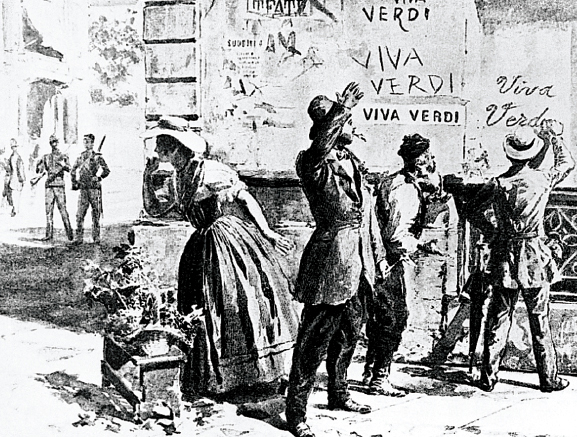Biography
Giuseppe Verdi (1813–1901)

The son of a storekeeper in a tiny village in northern Italy, Verdi had a spotty education. He played church organ and conducted the band of the neighboring little town. A local merchant, Antonio Barezzi, who became a patron and almost a second father to the young man, sent him to Milan to study music.
In those days, the center of musical life in Italy was Milan’s opera house, La Scala. (It is still active and world famous today.) After several discouraging years in that city, Verdi scored a huge success with his biblical opera Nabucco (Nebuchadnezzar) when he was twenty-
Italy was not an independent nation during Verdi’s youth. He was an ardent supporter of the Risorgimento, or Italian liberation movement, and many of his early operas had patriotic themes. The most beloved number in Nabucco was a nostalgic hymn of the Hebrew slaves in Babylon — a clear reference to the Italians under the heel of the Austrian Empire. In the year of revolution, 1848, Verdi wrote the rousing Battle of Legnano. VERDI actually became a patriotic acronym for the popular choice for king — Vittorio Emmanuele, Re d’Italia. After independence was achieved, the composer was made an honorary deputy in the first Italian parliament.

A dour character and a tough businessman, Verdi drove hard bargains with opera impresarios, bullied his librettists, and insisted on supervising the production of his new operas. After the premiere of Aida in 1871 in Cairo, Egypt — Verdi was internationally famous — he retired to a fine country estate near his birthplace and spent his later years hunting and raising livestock. He was coaxed out of retirement in the 1880s by his canny publisher and by an eminent librettist, Arrigo Boito. In his seventies, Verdi wrote his two greatest operas with Boito on Shakespearean subjects: the tragedy Otello and the comedy Falstaff.
Verdi’s first marriage, to the daughter of his early patron Barezzi, ended when his young wife and two babies died within two years. The composer bore the emotional scars of this tragedy all his life, and it may be that the many moving scenes between fathers and daughters in Verdi’s operas, including Rigoletto, served to channel his feelings about fatherhood. He later married a remarkable woman, Giuseppina Strepponi, a singer who had assisted him in his early career and starred in his first success, Nabucco. She had been Verdi’s partner for many years before their marriage.
By the time he died, at the age of eighty-
Chief Works: Twenty-
Encore: After Rigoletto, listen to La traviata (Act I), Aida (Act IV), Otello (Act I).
Verdi photograph:Bettmann/CORBIS.